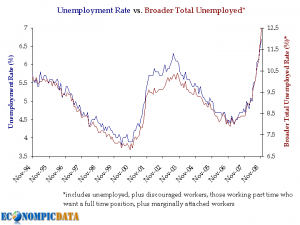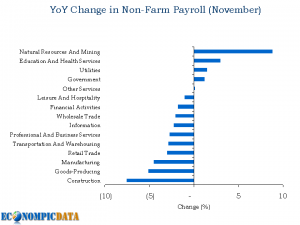Wow, that is really really ugly — the worst job loss in 34 years. This is the 11th straight month of job losses and the largest monthly decline since 1974.
Unemployment ticks up to 6.7%. 422,00 people left the labor force — had that not happened, we would have seen an even bigger unemployment rate.
Revisions downward are also big — September and October increased job losses by 199,000. We are now at nearly 2 million job losses for the year.
~~~
Look out below…
Sources:
THE EMPLOYMENT SITUATION:
BLS, NOVEMBER 2008
http://www.bls.gov/news.release/empsit.nr0.htm
charts via Econompic
THE EMPLOYMENT SITUATION: NOVEMBER 2008
Nonfarm payroll employment fell sharply (-533,000) in November, and
the unemployment rate rose from 6.5 to 6.7 percent, the Bureau of Labor
Statistics of the U.S. Department of Labor reported today. November’s
drop in payroll employment followed declines of 403,000 in September and
320,000 in October, as revised. Job losses were large and widespread
across the major industry sectors in November.
Unemployment (Household Survey Data)
Both the number of unemployed persons (10.3 million) and the unemploy-
ment rate (6.7 percent) continued to increase in November. Since the start
of the recession in December 2007, as recently announced by the National
Bureau of Economic Research, the number of unemployed persons increased by
2.7 million, and the unemployment rate rose by 1.7 percentage points. (See
table A-1.)
The unemployment rates for adult men (6.5 percent) and adult women (5.5
percent) continued to trend up in November. The unemployment rates for
teenagers (20.4 percent), whites (6.1 percent), blacks (11.2 percent), and
Hispanics (8.6 percent) showed little change over the month. The jobless
rate for Asians was 4.8 percent in November, not seasonally adjusted. (See
tables A-1, A-2, and A-3.)
Among the unemployed, the number of persons who lost their job and did not
expect to be recalled to work increased by 298,000 to 4.7 million in November.
Over the past 12 months, the size of this group has increased by 2.0 million.
(See table A-8.)
The number of long-term unemployed (those jobless for 27 weeks or more) was
little changed at 2.2 million in November, but was up by 822,000 over the past
12 months. (See table A-9.)
Total Employment and the Labor Force (Household Survey Data)
In November, the labor force participation rate declined by 0.3 percentage
point to 65.8 percent. Total employment continued to decline, and the employ-
ment-population ratio fell to 61.4 percent. (See table A-1.)
Over the month, the number of persons who worked part time for economic
reasons (sometimes referred to as involuntary part-time workers) continued
to increase, reaching 7.3 million. The number of such workers rose by 2.8
million over the past 12 months. This category includes persons who would
like to work full time but were working part time because their hours had
been cut back or because they were unable to find full-time jobs. (See
table A-5.)




What's been said:
Discussions found on the web: